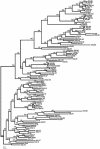Adaptive evolution in the Arabidopsis MADS-box gene family inferred from its complete resolved phylogeny
- PMID: 14597714
- PMCID: PMC263827
- DOI: 10.1073/pnas.1835864100
Adaptive evolution in the Arabidopsis MADS-box gene family inferred from its complete resolved phylogeny
Erratum in
- Proc Natl Acad Sci U S A. 2004 Jan 27;101(4):1110
Abstract
Gene duplication is a substrate of evolution. However, the relative importance of positive selection versus relaxation of constraints in the functional divergence of gene copies is still under debate. Plant MADS-box genes encode transcriptional regulators key in various aspects of development and have undergone extensive duplications to form a large family. We recovered 104 MADS sequences from the Arabidopsis genome. Bayesian phylogenetic trees recover type II lineage as a monophyletic group and resolve a branching sequence of monophyletic groups within this lineage. The type I lineage is comprised of several divergent groups. However, contrasting gene structure and patterns of chromosomal distribution between type I and II sequences suggest that they had different evolutionary histories and support the placement of the root of the gene family between these two groups. Site-specific and site-branch analyses of positive Darwinian selection (PDS) suggest that different selection regimes could have affected the evolution of these lineages. We found evidence for PDS along the branch leading to flowering time genes that have a direct impact on plant fitness. Sites with high probabilities of having been under PDS were found in the MADS and K domains, suggesting that these played important roles in the acquisition of novel functions during MADS-box diversification. Detected sites are targets for further experimental analyses. We argue that adaptive changes in MADS-domain protein sequences have been important for their functional divergence, suggesting that changes within coding regions of transcriptional regulators have influenced phenotypic evolution of plants.
Figures



References
Publication types
MeSH terms
Substances
LinkOut - more resources
Full Text Sources
Other Literature Sources
Miscellaneous

